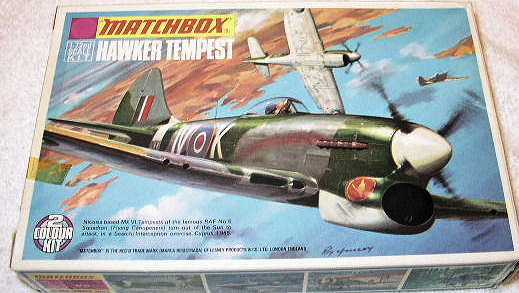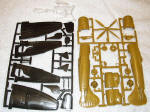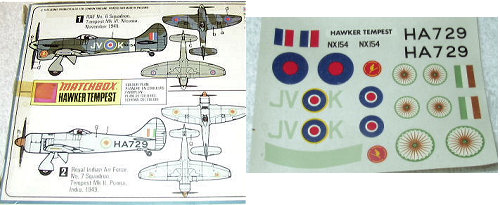
|
KIT: |
Matchbox 1/72 Hawker Tempest |
|
KIT #: |
PK-23 |
|
PRICE: |
$3.50 |
|
DECALS: |
Two options |
|
REVIEWER: |
|
|
NOTES: |
36 parts on 2 sprues; 4 clear on one sprue |

In March of 1940, Hawker initiated a number of design studies aimed at improving the Typhoon. Among these studies were ways of improving the Typhoon’s high altitude performance. These involved the use of a new wing design that featured a thinner wing section and a reduced wing area. The new wing had an elliptical planform and showed a great potential for increasing performance at altitude while reducing the tendency of the original Typhoon wing to buffet at speeds around 500 mph. The thin wing meant that alternative space for fuel had to be found and this was achieved by moving the engine 21 inches forward and inserting a 76 gallon tank between the firewall and the oil tank.
The Tempest Mk VI was basically a Tempest V airframe modified to accept the 2,340hp Sabre V engine. Externally similar to the Tempest V, the Mk VI featured wing root air intakes similar to those installed on the Tempest II. The use of wing air intakes, for the oil cooler and carburetor, left the nose area free to house a larger engine coolant radiator.
The Tempest Mk II had been intended to be powered by the 2,250hp Sabre Mk IVA in-line liquid cooled engine. Sir Sydney Camm however felt that the radial engine Tempest Mk II would offer the ultimate in performance for the Typhoon/Tempest line and, as a result, considerable effort was made to improve the efficiency of the 2,210 hp Centaurus air cooled radial engine. All production aircraft were fitted with the Centaurus V engine, the short-barreled Hispano Mk. V cannons and the standard Mk V tail-unit. All of Bristol’ aircraft and Hawkers first batch were built as fighters, while the rest of Hawker’s production aircraft were built as fighter-bombers with strengthened wings. The former were later modified to FB standard. The prototypes and early Hawker built aircraft did not have air filter intakes in the upper fuselage behind the engine cowling. Later production Mk IIs had also the pitot head moved from beneath the port wing to the port wing tip.
|
THE KIT |
 Upon
opening the box, you’re presented with two unbagged, colored sprues containing a
total of thirty-six (36) parts. A separate sprue, also not bagged, contains the
clear parts which consist of a closed windscreen & canopy piece and a
three-piece stand. One sprue’s parts are colored a dark yellow while the other
sprue’s parts are colored olive drab. The plastic is thick with heavy engraved
panel lines. Though the kit contains some flash, it is kept to a minimum.
Upon
opening the box, you’re presented with two unbagged, colored sprues containing a
total of thirty-six (36) parts. A separate sprue, also not bagged, contains the
clear parts which consist of a closed windscreen & canopy piece and a
three-piece stand. One sprue’s parts are colored a dark yellow while the other
sprue’s parts are colored olive drab. The plastic is thick with heavy engraved
panel lines. Though the kit contains some flash, it is kept to a minimum.
The cockpit is sparse and contains just a seat, pilot figure, and oxygen bottles. The kit includes different cowls for building either a Mk. VI (Napier Sabre inline variant) or Mk. II (Bristol Centaurus radial) version. The main landing gear is molded with strut covers attached. A nice touch is that, should the modeler wish to finish the model with the landing gear retracted, the kit provides separate strut covers to do this. The exhaust stacks for the Mk VI version are separate parts while the exhaust stacks for the Mk. II version are molded onto the cowl halves. No underwing stores are included. The pitot tube for the Mk. II version indicates that this is an early Mk. II version.
The 20 mm cannon gun barrels are molded integral with the wings but can be easily hollowed out with a mini-drill. The clear canopy piece is thick, although the framing is well defined and should be easy to paint. I expanded the profiles of the Mk. V Tempest contained in the Ducimus Camouflage & Markings booklet on the Hawker Tornado, Typhoon and Tempest to 1/72 scale and to assess the dimensions of the kit’s parts and am happy to say that the kit’s fuselage and wings matched up exactly to the expanded profiles.
The
instructions are well laid out, with the construction being broken down into 8
parts. The painting guide (exterior colors are indicated on the back of the
box) contains numbers for Humbrol Paint colors. Markings are provided for two
aircr aft; which are:
aft; which are:
Mk VI – RAF No. 6 Squadron, Nicosia, November 1945 (Dark Green and Ocean Gray topside over Medium Sea Gray underside)
Mk. II – Royal Indian Air Force, No. 7 Squadron, Poona, India 1949 (Overall natural metal)
The decals, although a little thick and somewhat faded, are well printed. I’ve read a couple of internet articles on the Mk. II version using the kit-supplied decals and they indicated that there were no problems with the decals.
|
CONCLUSIONS |
This kit is long out of production (the box indicates 1974!) and, if you can find one, it has “fun build” all over it. It looks like a relatively simple and quick build and will look good straight out of the box. Although it doesn’t contain some of the finer details of contemporary kits, it will be a nice addition to your collection.
Special thanks to John Krukowski for finding this kit for me!
|
REFERENCES |
The Hawker Tempest Page: http://www.hawkertempest.se/
If you would like your product reviewed fairly and quickly by a site that has nearly 350,000 visitors a month, please contact me or see other details in the Note to Contributors.